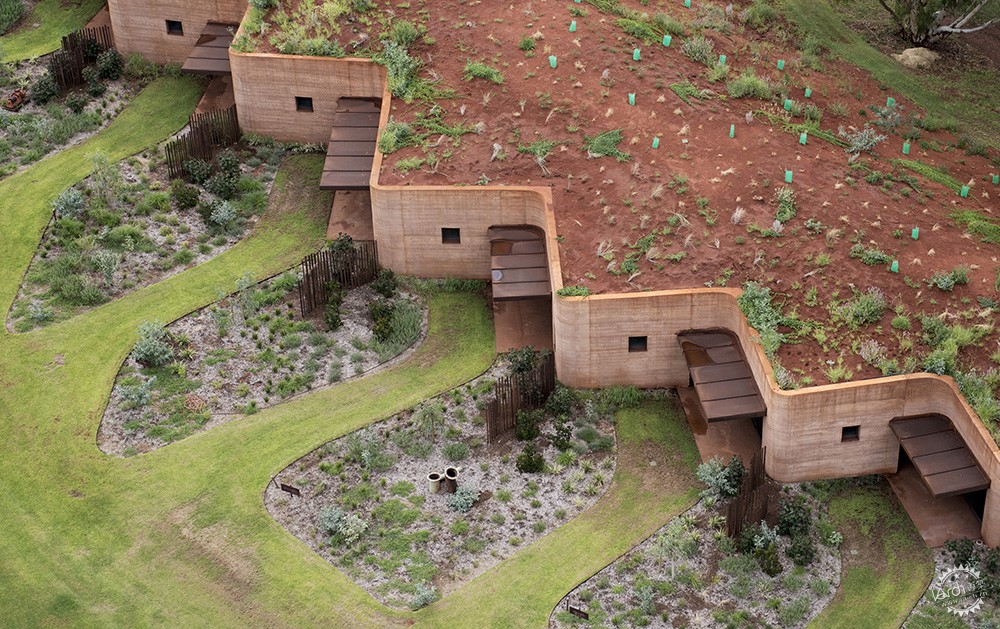
由专筑网Yumi,刘庆新编译
该项目由出生于意大利的澳大利亚的建筑师Luigi Rosselli设计,这些真实独特的建筑体现了澳大利亚内陆的景观和国土风情。
在澳大利亚西部一块儿干旱偏远的地块上,嵌入一个起伏的230米的夯土墙。W.A.的长城建筑设计灵感要追溯到在澳大利亚南部的Coober Pedy节俭务实的矿工地下住宅,甚至更远一些建筑形式,起先受到Bernard Rudofsky的称赞,出现在他的突破性的“没有建筑师的建筑”展览上,该展览在现代艺术学博物馆举行。
Designed by Italian-born, Australian-based architect Luigi Rosselli, these truly unique residences embody the landscape and vernacular of the Australian outback.
Embedded in an undulating 230 metre rammed earth wall in an arid, remote enclave in Western Australia, The Great Wall of W.A. harks back to the frugal material pragmatism of opal miners' subterranean dwellings in Coober Pedy, South Australia, or even further afield to some of the vernacular forms first celebrated by Bernard Rudofsky, in his ground-breaking Architecture Without Architects exhibition at MoMA.
了解真正的人道主义和环保的原则,Rosselli学习和研究了一些二十一世纪末最有影响力的建筑师,包括Alvaro Siza和Mario Botta。新的澳大利亚议会大厦奖,在1981年授予了纽约的公司Mitchell,Giurgola和Thorp建筑事务所,Rosselli去了澳大利亚成为建筑设计团队的一部分。从那以后,他在澳大利亚附近设计了数以百计的项目和现场响应的项目,成为了悉尼Luigi Rosselli建筑事务所的代表。
Informed by genuine humanist and environmental principles, Rosselli cut his teeth studying with and working for some of the most influential architects of the late twentieth-century, including Alvaro Siza and Mario Botta. The award of the new Australian Parliament House commission to New York firm Mitchell, Giurgola and Thorp Architects in 1981, saw Rosselli move to Australia as part of the design team. Since then, he has designed hundreds of program and site-responsive projects around Australia, as principal of Luigi Rosselli Architects, Sydney.
W.A.的长城建筑由12个土覆盖的住宅组成,在牲畜集中季节提供短期住宿。整体的土墙有450毫米厚,沙丘和沙漠植物组成的后壁/屋顶,它们拥有丰富的自然热质量。创造的室内空间非常适合恶劣的亚热带气候。在极端温度的昼夜波动下,通过天然材料缓慢释放的冷气和温暖,使该地区的特征得到缓和。
The Great Wall of W.A. consists of twelve earth-covered residences, providing short-term accommodation during the cattle-mustering season. Monolithic earth walls of 450mm thickness and rear wall/roofs of sand dune and desert foliage are endowed with an abundance of natural thermal mass, creating interior spaces perfectly suited to the harsh, sub-tropical climatic conditions. Extreme diurnal fluctuations in temperature, characteristic of the region, are mitigated by the slow release of coolth and warmth from the natural materials.
丰富而生动色调的夯土墙是由砂质粘土制造出来的,有很高的铁含量,从基地挖掘,骨料来源于附近的河流,水源来自于当地凿孔获得。除了十二个住宅,该建筑综合体还包含一个多功能的枢纽、会议室和教堂。密切关注细节和材料与自然环境的关系,通过所有的建筑形式,延续权利,光滑的混凝土板的红色的色调明显地从当地的河流中聚集。内部空间由Sarah Foletta设计,延续了材料和建筑的对话,创造了严谨和自然高雅的空间。
The rich and vivid tones of the rammed earth facade is created by a sandy clay, with a high iron content, dug from the site, aggregate sourced from a nearby river, and water sourced from a local bore. Alongside the twelve residences, the complex also contains a multi-functional hub, meeting room and chapel. The close attention-to-detail and material relationship to the natural surroundings is continued right throughout all built forms, with the aggregate from the local river evident in the reddish-tinge of the polished concrete slab. Interior spaces, designed by Sarah Foletta, continue the material dialogue of the architecture, creating restrained and naturally elegant spaces.
在泥土色和轮廓中,有一个意想不到的和引人注目的设计元素:一个金色的电镀氧化铝复合天花板,在教堂的斜锥形的屋顶结构上。顶点的天窗,创造了一种惊人的审美,加强了夯土墙和干旱的土壤与教堂的关系。
Amidst the earthy palette and contours, there is one unexpected and conspicuous design element: a golden anodised aluminium clad ceiling, within the obliquely conical roof structure of the chapel. Lit from a skylight at the apex, this creates a striking aesthetic contrast, enhancing the chapel's relationship to the attending rammed earth walls and arid terroir.
关于这种设计方法,Rosselli认为他是“以人为本,人与环境优先于预先构思设计的教条”。
这个“以人为本”是明显地对于夯土结构的形式和材料的重新考虑,和表达了当地居民与自然环境的直接关系。这是在土地里的住宅,令人回味的杰作沉浸在传统现象学中,像彼得•卒姆托,而批判的地域主义由Kenneth Frampton在1980年推广。
WA的长城项目入围了澳大利亚建筑师协会的参赛作品,获得“西方澳大利亚建筑奖”。
Of his design methodology, Rosselli maintains that his approach is "humanist, where people and environment take precedence over pre-conceived design dogmas." This 'humanism' is evident in the way the forms and materiality of the rammed earth structures reconsider and frame the inhabitants' relationship to the immediate natural environment. These are dwellings in and of the earth, evocative of masterworks steeped in the phenomenological tradition, like those of Peter Zumthor, but also of the critical regionalism popularised by Kenneth Frampton in the 1980's.
The Great Wall of WA was selected as a finalist in the Australian Institute of Architects - Western Australia Architecture Awards.
出处:本文译自www.arcspace.com/,转载请注明出处。
|
|
